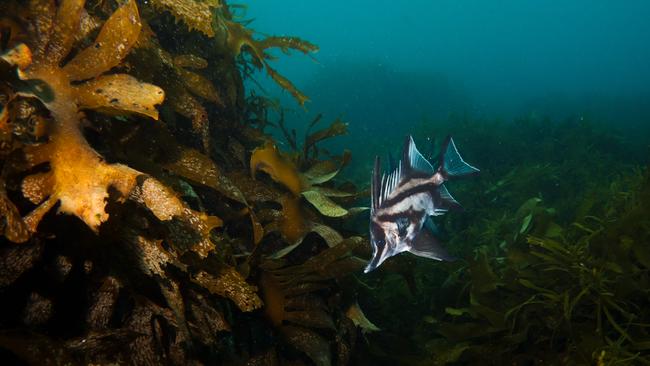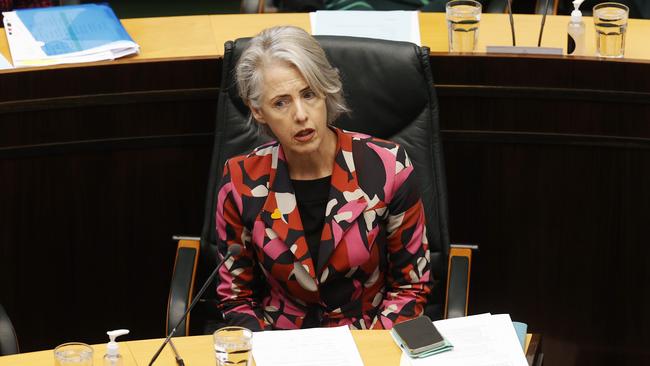State of the Environment Report 2024: Long-delayed review paints grim picture, makes 16 recommendations
After a decade-long delay, the State of the Environment Report has finally been released, making a series of findings, described as “deeply concerning”. Here’s what’s been recommended.

Tasmania
Don't miss out on the headlines from Tasmania. Followed categories will be added to My News.
Rising sea temperatures, coastal erosion, vegetation loss, and the disappearance of kelp forests have all been identified as “significant” environmental challenges facing the state in a report that has finally been released after a decade-long delay.
The State of the Environment Report 2024 details baseline environmental data, trends, and risks across Tasmania. Until Tuesday, an updated version had not been published since 2009, despite legislative requirements dictating it be produced every five years.
The sobering document, prepared by the independent Tasmanian Planning Commission (TPC), found that Tasmania had lost at least 3 per cent of its native vegetation – which plays a crucial role in the state’s ecosystem – over the last 15 years, likely as a result of illegal clearance.

The two-volume report, which makes 16 recommendations to the state government, said the warming of seas around Tasmania was occurring at a faster rate than the global average and beaches were “showing signs” of erosion due to rising sea levels and dwindling kelp forests.
“It will require determination, commitment, creativity, innovation, co-ordinated effort, strong and careful leadership and significant investment to ensure that our environment remains an ongoing source of pride for all Tasmanians,” the report said.
According to the TPC, the impact of pests on Tasmania’s natural values had worsened since 2009, with some spreading to the Tasmanian Wilderness World Heritage Area.
The number of endangered and vulnerable flora has risen dramatically since 2008, the report stated, increasing by 41 species to a total of 230 in 2022. Meanwhile, the number of threatened fauna species rose in every habitat type between 1995 and 2023.
The report rated components of the Tasmanian environment according to their condition and whether or not they were improving.
It classified sea surface temperature, kelp, threatened marine fish, migratory shorebirds, native vegetation extent and fragmentation, threatened flora, and threatened fauna as being in poor condition and “getting worse”.
The report’s recommendations include the development of a long-term vision and strategy for the state’s environment; the establishment of further marine protected areas; a review of Tasmania’s coastal policy; and an end to illegal vegetation clearance.

Greens leader Rosalie Woodruff said the State of the Environment Report was “deeply concerning” and showed that the Liberal government had been “refusing to value and protect our environment”.
“Things are getting worse, and they are already rated as being at a bad place,” she said.
Environment Tasmania executive officer James Overington said it was alarming that 27 of the 29 indicators in the report were categorised as either “getting worse”, “stable”, or “unknown”.
“A complete shift in government decision-making will be required to turn these trends around and that needs to start right now,” he said.

Planning Minister Felix Ellis said the government was reviewing the report’s findings and recommendations.
“We are committed to sustainable management of our environment while also continuing to pursue economic development opportunities, ensuring Tasmania remains the best place to live, work and raise a family,” he said.
The 16 recommendations to the state government
• Recommendation 1: Develop a long-term vision and strategy for Tasmania’s environment
• Recommendation 2: The Commission recommends that the Tasmanian Government explore opportunities to collaborate with the Aboriginal community in ways that continue to incorporate Aboriginal knowledge and values into better care of the environment.
• Recommendation 3: Develop an environmental data strategy
• Recommendation 4: Contemporary RMPS (Resource Management and Planning System) objectives and legislation
• Recommendation 5: Establish more marine protected areas
• Recommendation 6: Undertake a review of Tasmania’s coastal policy
• Recommendation 7: Support the collection and analysis of fisheries independent data
• Recommendation 8: Improve native vegetation mapping and information
• Recommendation 9: Implement measures to end illegal vegetation clearance
• Recommendation 10: The Commission recommends that the Tasmanian Government continue to invest in Tasmania’s terrestrial reserve system in order to maintain the integrity of the current reserve estate
• Recommendation 11: Implementation of a statewide soil monitoring program
• Recommendation 12: Strengthen fire management activities
• Recommendation 13: The Commission recommends that the Tasmanian Government support the regular review of programs dealing with biosecurity matters and invasive species to ensure these programs are properly resourced, strengthened, and prioritised.
• Recommendation 14: Development of a broader water policy, monitoring and reporting approach
• Recommendation 15: Air quality monitoring and emissions reduction across all sectors
• Recommendation 16: Implementation of the Waste and Resource Recovery Strategy
More Coverage
Originally published as State of the Environment Report 2024: Long-delayed review paints grim picture, makes 16 recommendations





